Table of Contents
Join Thousands of Hotels Thriving with roommaster
The transition to roommaster is straightforward and efficient. Our implementation team handles data migration including reservations, guest profiles, and historical information.
Imagine a traveler landing on your hotel’s website, eager to book a stay. Within seconds, to be more precise, in .5 seconds they’ve become frustrated by slow load times, confusing navigation, and outdated visuals. In fact, an adobe consumer content survey says 38% of users will leave a website if they find its design poor. That’s more than a third of the possible clients!
To captivate potential guests and drive bookings, your hotel website must be an immersive experience that reflects the unique charm of your property. This involves optimizing aesthetics, ensuring responsiveness across all devices, and streamlining the booking process. To position your hotel as the preferred choice among discerning travelers you need to invest in a well-crafted website design.
In this blog, we’re going to see how to design a hotel website, what do the best hotel website designs have in common, and some of the best hotel website design templates.
Hotel website design is the process of creating a website design for your hotel that is visually appealing, user-friendly, and optimized so visitors can convert to guests. To get a great hotel website design it must have high-quality images, intuitive navigation, and responsive layouts for all devices. The main objective is to get potential travelers from their very first interaction, give them the information they are looking for, and help them with their booking process, enhancing the guest experience.
Before you start designing a successful hotel website, it’s important to clearly define your brand’s unique value and find the best way to showcase it, and this is important because 75% of website visitors decide if your company is credible based on its site design. Here’s how to get started:
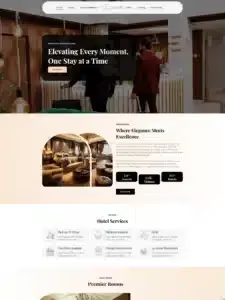
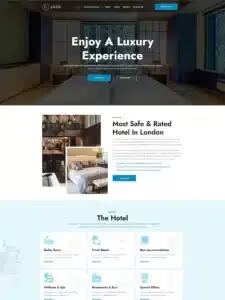
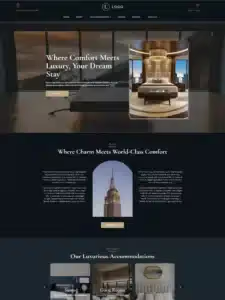
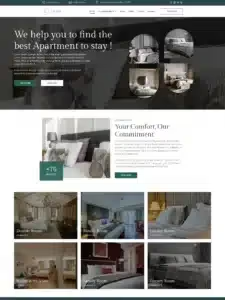
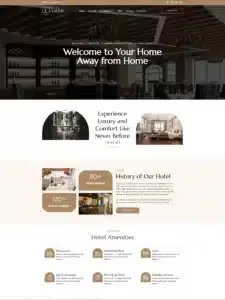
Top-performing hotel websites have several characteristics in common to enhance user experience and drive bookings:
When building your website, it’s important to ensure that it’s accessible to all users, including those with disabilities. Include features like text resizing options, high-contrast modes, and screen reader compatibility to make your site more inclusive.

Use a responsive design to adapt to various screen sizes and devices, thus providing an optimal experience whether your viewing on a desktop, tablet, or the telephone.
In our blog “The Psychology Of Hotel Website Design” we have some psychological tips to enhance your website.
Using high-quality images and videos can enhance your property’s amenities and ambiance, persuading potential guests by providing a virtual tour of what they can expect.
Displaying room rates and real-time availability in a very clear way builds trust and simplifies the booking process, reducing users’ confusion.
‘Book Now’ buttons placed strategically in your website encourage immediate action, guiding visitors toward making reservations.
Implementing effective SEO strategies, including keyword optimization and quality content, improves search engine rankings, increasing your website’s visibility to potential guests.
If you’re trying to enhance the user experience, work on applying intuitive navigation, quick load times, and a straightforward booking process, so visitors will be more likely to complete a reservation.
Incorporating some local attractions ensures your hotel appears in relevant search results, so you can attract travelers that may be interested in your area.
A seamless, secure hotel booking engine integrated into your website allows guests to make reservations without being redirected, providing a cohesive and trustworthy experience.
If you start incorporating these elements, your hotel website will stand out in a competitive market. If you want to read more about this practices, we have the right blog for you: What is Hotel Website Design?
{{hotel-website-builder}}
We got to the conversion part, here are five design tips that can give your hotel website a serious conversion boost:
Try using dynamic content to prepare recommendations, special offers, and local insights made for each guest based on visitor behavior, you can analyze past data using roommaster’s hotel management software. Personalizing your offers builds a sense of trust that encourages bookings.
Tell your story, not just with words but with a visual narrative that captures your hotel’s unique charm. Create engaging videos, and immersive galleries to transport potential guests into your fascinating story, making them more likely to click that ‘Book Now’ button.
Invite users to explore your property through interactive features like virtual tours, real-time chat support, and dynamic maps. These tools create an immersive experience, that keeps visitors entertained so they can stay on your site longer.
Analyze your user journey with tools like A/B testing to optimize every step, you can analyze everything from landing page to checkout. Change call-to-action placements, button designs, and form simplicity every once in a while to minimize friction, ensuring a smooth transition from interest to confirmed booking.
Use authentic guest testimonials, positive reviews, and industry accolades to establish credibility. Showing real experiences makes potential visitors more confident, making them feel trust in choosing your hotel for their next stay.
The first impression a hotel makes very often starts with its website. A well-designed hotel website doesn’t just look beautiful; it tells a story, engages potential guests, and, ultimately, converts casual visitors into loyal customers. From visually stunning photography to seamless booking experiences, these hotel websites illustrate how good design can enhance a guest’s journey from browsing to booking. Let’s explore the best practices that make each of these eight hotel websites stand out.
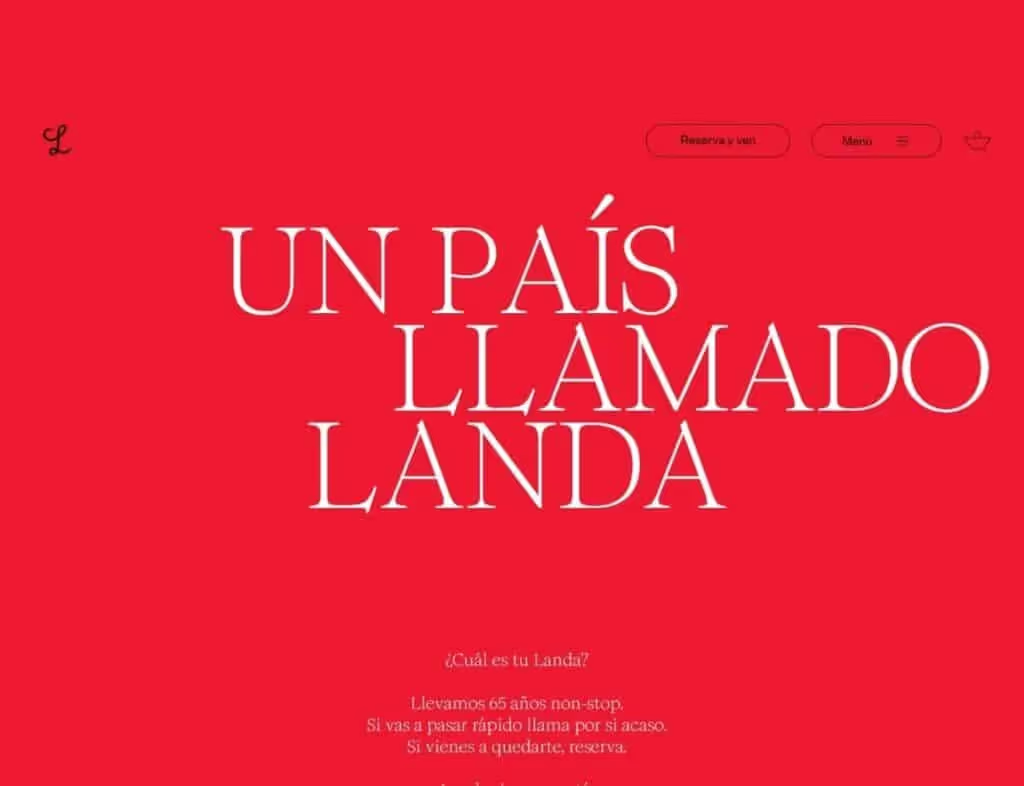
The Hotel Landa website offers a masterclass in storytelling. Upon landing on the homepage, you are immediately immersed in the grandeur of its historical setting. The large, high-quality images are carefully curated to reflect the hotel’s old-world charm, creating an emotional connection before a single word is read.
But beyond the visual appeal, the real strength lies in its simplicity. The minimalist layout guides visitors effortlessly through the site. No unnecessary elements clutter the user’s journey, allowing them to focus on the essentials: the hotel’s unique atmosphere and the “Reserve Ahora” (Book Now) button, which remains a consistent companion as you scroll.
Key Takeaways: Stunning photography combined with a minimalist design and clear CTAs can make your website both engaging and conversion-focused.
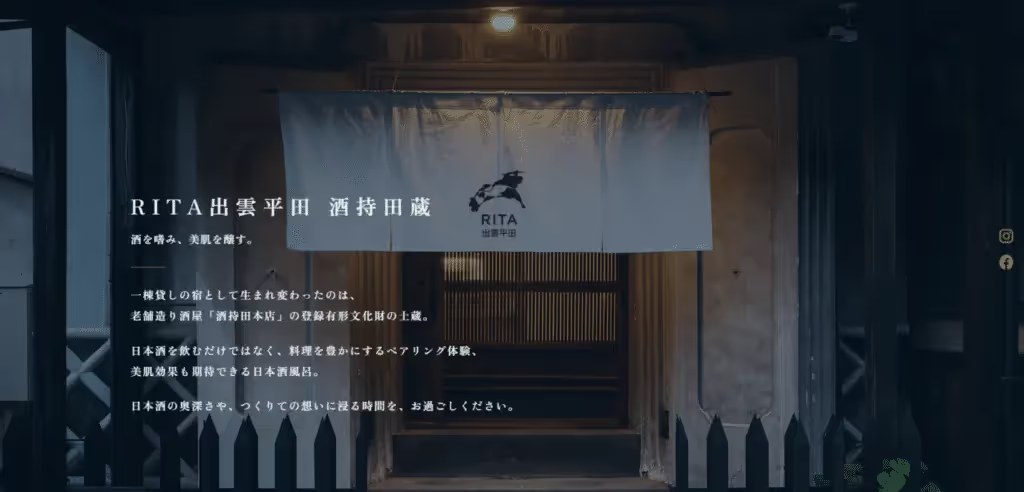
For the Rita Izumo Hirata Hotel, simplicity is the winning strategy. This site doesn’t distract visitors with excessive content or complex navigation. Instead, it leads them directly to the heart of the matter: booking a stay.
With an intuitive interface, potential guests can easily browse room options and plans. The clean, no-frills layout ensures that visitors have everything they need to make a decision without being overwhelmed by unnecessary distractions. In addition, the seamless booking process, which is at the beginning of the design, reduces friction and increases the likelihood of conversions.
Key Takeaways: Simplicity and efficiency in design can be just as powerful as visual complexity when the focus is on driving bookings.

The Vesper Hotel understands that guests are not just booking a place to sleep: they’re booking experiences. The website takes full advantage of this mindset by highlighting unique, experiential offerings through dedicated pages for “Special Experiences.” Whether it’s a luxurious beachside dinner or a romantic weekend package, Vesper knows how to make guests dream.
The design makes excellent use of white space, giving the site a modern, sophisticated feel. Moreover, the persistent “Book Now” button follows you down the page, making the transition from browsing to booking as effortless as possible.
Key Takeaways: Highlighting unique experiences and maintaining persistent booking options can significantly enhance user engagement and lead to more reservations.
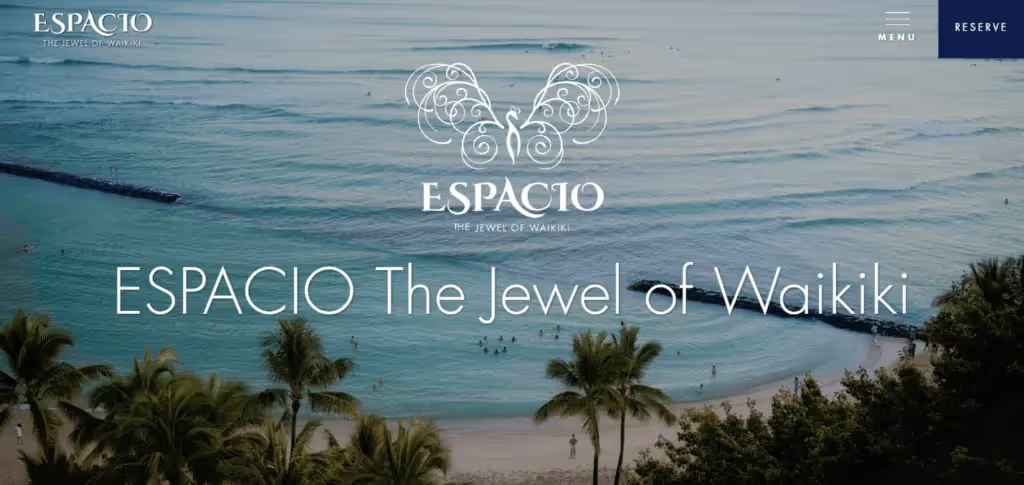
The moment you land on the Espacio Waikiki website, you’re greeted with stunning visuals that transport you straight to the beautiful beaches of Waikiki. The site’s photography does more than just showcase rooms, it sells the entire vacation experience. Guests can almost feel the sun and hear the waves, long before they even pack their bags.
In addition to its mesmerizing visuals, the website makes excellent use of its hotel booking engine. Prominently displayed at the top of the homepage, the booking feature is easy to find and simple to use, encouraging visitors to check room availability without delay.
Key Takeaways: High-quality, immersive visuals paired with a prominent booking engine can significantly enhance the user experience and drive bookings.
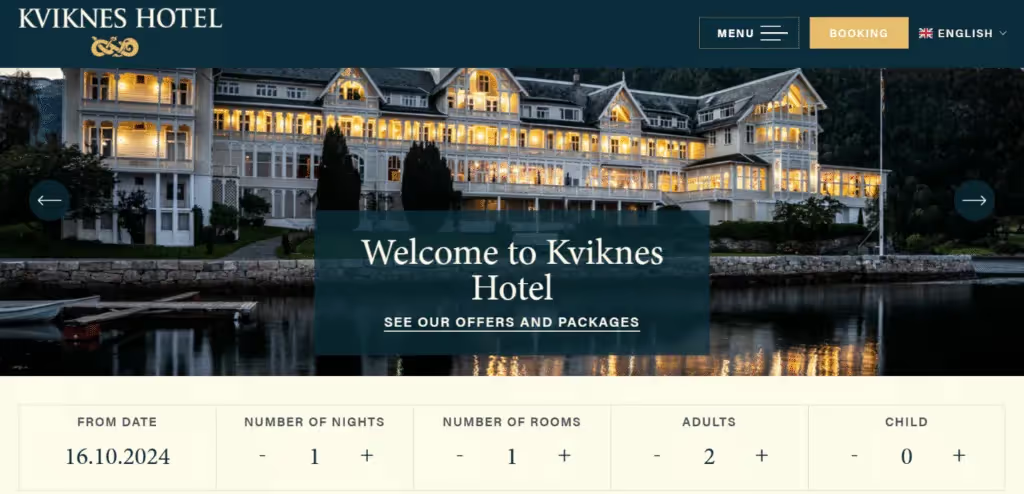
The Kviknes Hotel website draws you in with its rich history, immediately setting itself apart from the competition. The home page beautifully blends modern design elements with the hotel’s 150-year-old heritage, telling a story that appeals to both history lovers and modern travelers.
A standout feature is the site’s multilingual options, making it accessible to a broader audience. By offering English, Norwegian, and other language options, Kviknes shows it understands the value of a global clientele.
Key Takeaways: Storytelling through history and offering multilingual options can broaden a hotel’s appeal and create a more inclusive user experience.

With its strong Western theme, the Gage Hotel website exudes personality. Every element of the design reflects the hotel’s rustic charm, giving potential guests a true sense of what to expect during their stay. This visual identity not only attracts visitors but also ensures that they feel connected to the property long before they arrive.
The mobile-friendly design ensures that the website functions perfectly across devices, an increasingly important feature in today’s mobile-first world. With many guests browsing and booking via smartphones, this responsiveness is crucial for conversion success.
Key Takeaways: A strong visual identity paired with a mobile-friendly design can enhance both user engagement and booking conversions.
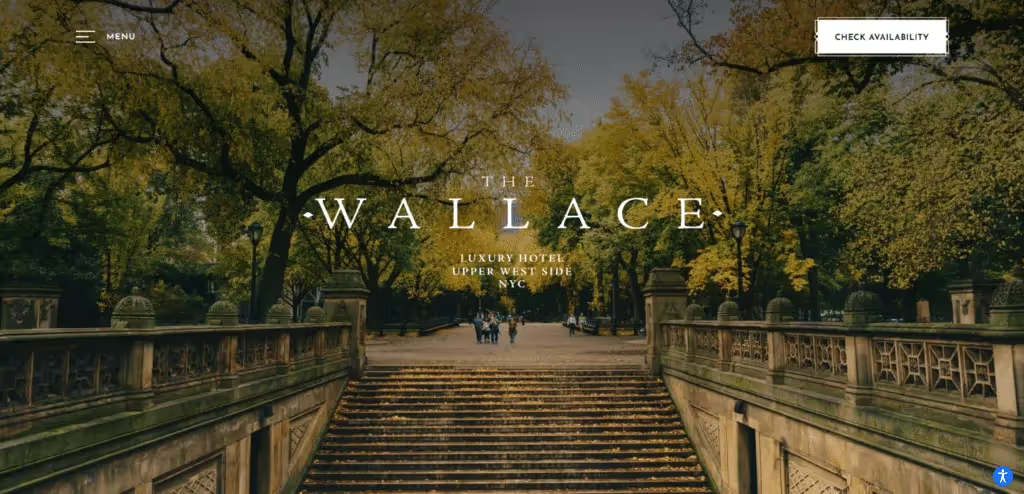
For luxury hotels, the website needs to communicate elegance—and The Wallace delivers. From the rich color palette to the sleek fonts, every detail of this website reinforces the upscale nature of the hotel. The emphasis on luxury is clear, and it’s reflected in every design decision.
A key feature here is the fast-loading pages. Despite using high-quality images, the website’s performance is optimized to ensure fast load times. This is particularly important for reducing bounce rates and improving the overall user experience.
Key Takeaways: Fast-loading content paired with a luxurious design ensures a seamless experience, keeping users engaged and more likely to book.
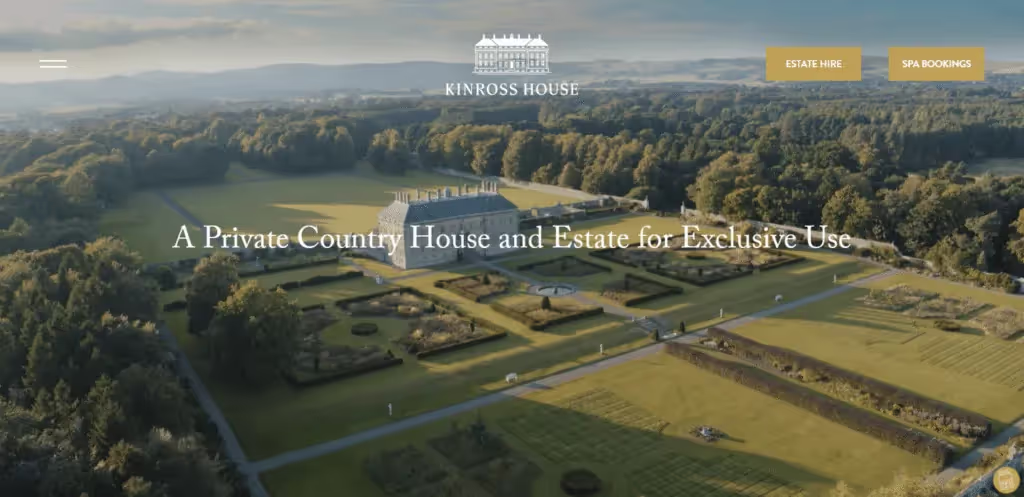
The Kinross House website combines immersive imagery with elegant design to showcase the grandeur of its historic estate. The homepage features full-screen images that immediately capture attention, inviting visitors to explore the property virtually before they book a stay.
Strong CTAs like “Enquire Now” encourage visitors to take the next step, whether it’s booking a stay or planning an event at the estate. These well-placed, inviting CTAs are essential in driving user engagement.
Key Takeaways: Immersive imagery combined with personalized CTAs can create a compelling user experience that encourages bookings and inquiries.
At roommaster Hotel Website Builder, we believe your hotel’s website is a powerful revenue engine. Our complete solution is designed to turn browsers into guests by blending cutting-edge technology with great design.
{{pms-five}}
A: Hotel website design is the process of creating a website design for your hotel that is visually appealing, user-friendly, and optimized so visitors can convert to guests.
A: The best hotel website design combines stunning visuals, clear and simple navigation, fast load times, and effective SEO strategies. It ensures that potential guests find the information they need quickly while providing a seamless booking experience on any device.
A: Responsive design guarantees that your website adapts effortlessly to various devices like desktop, tablet, or mobile. This improves user experience and helps capture last-minute bookings from guests on the go.
A: Enhancing direct bookings involves streamlining the booking process with minimal form fields, prominent “Book Now” buttons, and integrated hotel booking engines. Additionally, personalized recommendations and real-time availability can further encourage guests to complete their reservations.
A: SEO is critical in making your website discoverable. A well-optimized hotel website ranks higher in search results, attracts more organic traffic, and ultimately leads to increased direct bookings by aligning content with what potential guests are searching for.
{{cta-strip}}

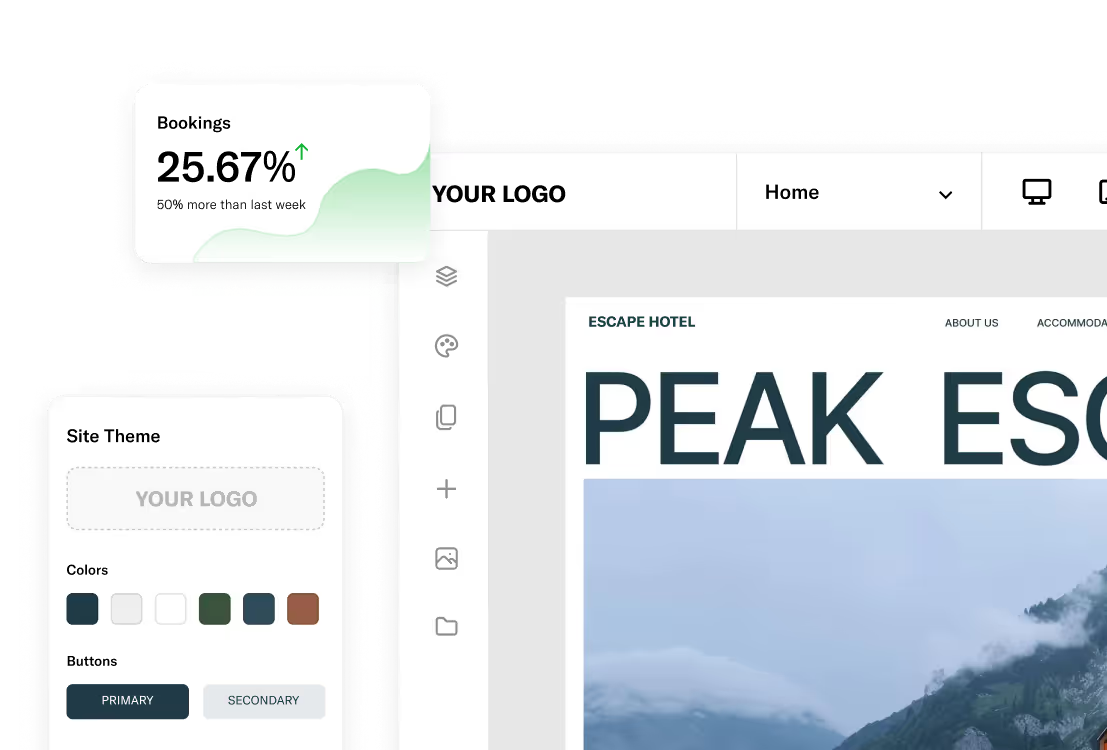
The transition to roommaster is straightforward and efficient. Our implementation team handles data migration including reservations, guest profiles, and historical information.
See how roommaster's unified platform can work for your property. Our team will walk you through features tailored to your specific needs and operations.